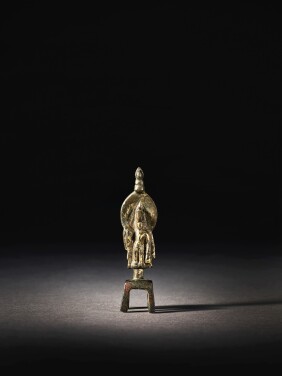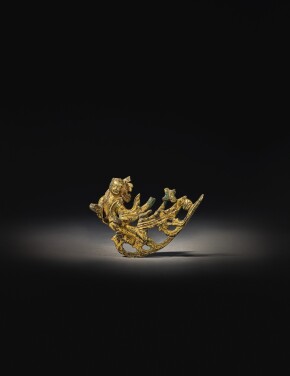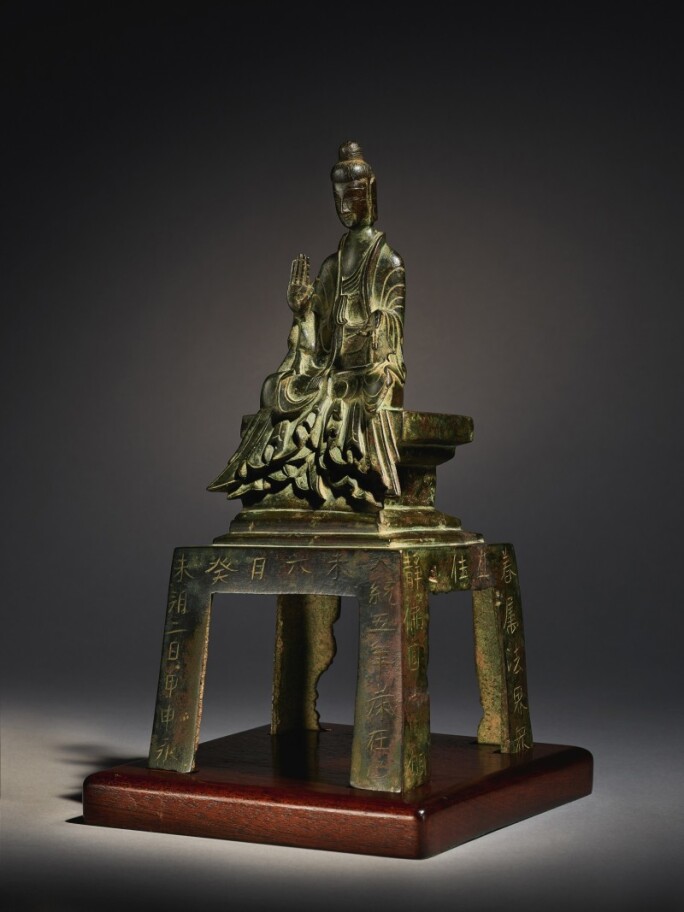The bronze sculptures in the Jane and Leopold Swergold Collection superbly capture the diverse and evolving cultural values of Buddhist imagery in China from the 5th to 10th centuries. Professor Annette L. Juliano discusses the sweep of history in the gilt bronze sculptures that together convey the development and sophistication of China’s second great empire.
I n the 1980s and 1990s, the Western world rediscovered the fabled Silk Road, which actually comprised several routes moving overland between East Asia and the eastern Mediterranean.1 Overland transport was also paralleled with maritime routes; archaeological activity during the last two decades off the coast of China salvaged shipwrecks laden with merchandise bound for west Asian ports as well.2 This upsurge of interest in these ancient global interconnections spurred a flurry of 'Silk Road' exhibitions in museums and galleries around the world.
Trade routes carried not only ‘goods’, but also people and ideas. For China, this meant the arrival of the Buddhist religion, introduced by proselytizing itinerant monks from India and Central Asia, bearing sacred sutras, small icons, and religious ritual paraphernalia.
Along the Fabled Silk Road
By the 4th century CE, Buddhism began to have a profound effect on China, particularly in the North, literally transforming the landscape with massive cave temples carved out of the living rock, multi-storied stupas, stone, bronze, wood, and stucco sculptures, and wall paintings.
In 386 CE, the nomadic group known as the Tuoba Xianbei conquered the North and established the Northern Wei dynasty (386-535) and divided China into the Northern and Southern Dynasties (386-589). The Tuoba, ardent supporters of Buddhism, lent their imperial patronage to open several of the most famous cave temple sites, familiar to anyone who has travelled China, particularly Yungang in Datong, Shanxi province and Longmen in Luoyang, Henan province. One Chinese source estimated that there were 2 million newly converted Buddhist monks and nuns during the Northern Wei dynasty, 47 national temples were built, and more than 30,000 temples were constructed by the common people.3
The Spread of Buddhism Across a Fractious Empire
During this period of political disunity and incessant internal strife, Buddhism flourished in northern China’s highly diverse culture under the rule of the Tuoba Xianbei; nomadic culture encountered not only traditional Han culture of the Central plains, but also foreign diplomatic delegations, merchants, itinerant artisans, and monks arriving via the Silk Routes.4 At this time, the production of Buddhist sculpture expanded considerably to meet the growing demand of the faithful, and also spurred by the popularity of the Lotus Sutra which preached the importance of image making to gain merit for the artisan and the donor on their path to enlightenment. These early sculptures betray the convergence of cultural elements from Gandharan, Kushan, Central Asian and traditional Chinese sources.
The Development of Buddhist Imagery Across Centuries
The 25 small gilt bronze sculptures in the Jane and Leopold Swergold Collection superbly capture the diverse and evolving cultural values of this rapidly growing body of Buddhist imagery from the 5th to 10th centuries. The seven earliest examples (lots 3501-3504, 3506, 3507 and 3515) manifest the complex stylistic and iconographic development of Buddhist sculpture during the Northern and Southern Dynasties. The next four (lots 3508-3511), reflect the synthesis of sculptural styles that began to emerge during the Sui dynasty (589-618), a very brief period of re-unification of China. Finally, the fourteen magnificent Tang dynasty (618-906) Buddhist figures convey the sophistication and cosmopolitanism of the second great empire in China’s history.
These three figures from the earliest group (lots 3501, 3503 and 3515) express some of the challenging aspects of these evolving sculptural forms. With the intersection of multiple cultural influences, it is often difficult to clearly identify direct sources. Strikingly simple and repetitive parallel lines of lot 3501 define the Amitabha Buddha’s golden aura and infinite light; the articulation of the drapery seems to resonate with Gandhara prototypes. A similar technique survives into the early 6th century on some Shaanxi stone steles.5 Although dated 539, five years after the collapse of the Northern Wei, this seated Buddha (lot 3503) presents the iconic sculptural form of pointed cascading drapery and tied sash that is considered a totally Sinicized style that occurs in the early 6th century at the Longmen Cave temples opened by the Northern Wei.6 The origin of distinctive style has been debated by scholars as an innovation of the Northern Wei or influenced by earlier Southern Buddhist examples.7 Dated 544, the Eastern Wei (535-550) standing Padmapani bodhisattva (lot 3515) retains strong connections to sensual Indian forms; at the same time, the pointed pectoral at the neck may have been derived from nomadic cultures in Mongolia since it is found extensively on bodhisattvas in the caves at Yungang and in nomadic burials in Mongolia.8
Lasting for less than 40 years, this Sui’s brief unification of China produced a new sculptural synthesis, a majestic style of restrained elegance and controlled sensuality (lots 3508, 3509, 3510 and 3511) which formed the basis of Tang dynasty Buddhist sculpture. The Tang sculptures here include six representations of Avalokiteshvara, known in Chinese as Guanyin, one of the most popular, Mahayana devotional deities in China. Also known as Guanshiyin, literally translating as one who hears or observes the sounds of suffering in the world; the “Goddess of Mercy” personified the idea of compassion becoming a powerful agent of mercy and salvation. When the magical chant, the name Guanyin, is invoked sincerely, salvation from any hardship was believed to be at hand (lots 3505, 3513, 3516 and 3518). Lots 3513 and 3517 show an esoteric Buddhist version, one with eleven heads and the other with 'thousand arms'.
All of the images express the Tang ideal of softly rounded, yet solid forms of the body, pliant poses which imbue the deities with a tactile sensuous beauty. These forms achieve the exquisite balance between realism and stylization and between the divine and the secular.
In Search of the Past
Researching and studying Buddhist gilt bronzes offers significant challenges. Unlike sculpture and painting in monumental Buddhist cave temples carved out of mountain sides, these small gilt bronzes have been separated from their original contexts. In addition, gilt bronzes were often melted down to recover the valuable metals; the remains of scraped-off gilding can often be seen on small and large stone statues that originally had extensive gilded embellishments. Although there are texts describing monumental gilt bronze Buddhas in temples, and a very few survived such as the 55½ inch Maitreya in the Metropolitan Museum of Art, most Buddhist images were cast in highly portable sizes.
Hundreds of small gilt bronzes dating from the Northern Dynasties through the Tang dynasty were sometimes buried within the grounds of what were once temple compounds or nunneries long ago destroyed during periods of political chaos or Buddhist persecutions.10 Some of the gilt bronzes in these hoards were originally part of altar assemblages, like four images in the Swergold Collection (lots 3515, 3516, 3521 and 3522), figures standing on lotuses with small shafts projecting from the bottom to slot into the proper position. Yang Xuanzhi’s Record of Buddhist Monasteries in Luoyang, dated 547, describes one of the most lavish such altars, Yongning Temple. Apparently, 30 “golden statues” were deposited in a deep underground chamber under a nine-storey wooden pagoda part of the Yongning Temple complex in Luoyang built in 516 for the Northern Wei Empress Ling.11
The 25 Buddhist gilt bronze images selected by Jane and Leopold Swergold offer an exceptional range of iconography, quality and beauty. The powerful presence and shimmering spirituality of these sculptures belie their small size.
1 Literature about the Silk Road is prodigious. The following two publications provide an excellent overview as well as more detailed information, Susan Whitfield, Life Along the Silk Road, Berkeley, 1999 and The Silk Road: Trade, War, and Faith, Chicago, 2004.
2 An Jiayao, ‘The Development of Archaeology in China: A Ninety Year Journey’, in Annette L. Juliano, Unearthed Recent Archaeological Discoveries from Northern China, New Haven and London, 2012, pp. 158-159 (total pages in the article, pp. 141-162).
3 Kenneth K.S Ch’en, ‘Anti-Buddhist Propaganda during the Nan-Ch’ao’, Harvard Journal of Asiatic Studies, vol. 15, no. 1/2 (June), p. 167 (total pages in the article 166-92).
4 For a general introduction to the development of Buddhist art from the Northern Wei through the Tang dynasty in north China, see Annette L. Juliano, Buddhist Sculpture from China, Selections from the Xi’an Beilin Museum, Fifth through Ninth Centuries, The China Institute Gallery, New York, 2007, pp. 1-23.
5 See Terukazu Akiyama, Saburo Matsubara, and Alexander C. Soper, Arts of China, Buddhist Cave Temples, New Researches, Tokyo and Palo Alto, CA, 1969, 160, p. 233, no. 150. Interestingly, there are two very similar small bronze steles employing the same parallel technique found in Inner Mongolia; unfortunately, they remain unpublished.
6 The more “Chinese style” is actually first seen in Yungang Cave temples in the 490s, Cave 5, 6. Zhongguo meishu quanji: Diaosu bian 10: Yungang shiku diaoke [Complete works of Chinese Art, Sculpture, vol. 10: Yungang cave temple carvings], Beijing, 1988, pp. 32-71.
7 See Alexander C. Soper, ‘Southern Chinese Influence on the Buddhist Art of the Six Dynasties Period’, Bulletin of the Museum of Far Eastern Antiquities (Stockholm), no. 32, pp. 42-112. Katharine R. Tsiang, ‘Reconsidering Early Buddhist Cave-Making of the Northern Wei in Terms of Artistic Interactions with Gansu and the Western Regions’, Journal of Inner Asian Art and Archaeology, no. 4, 2009, pp. 101-118.
8 Chen Yongzhi, Song Guodong, and Ma Yan, ‘The Results of the Excavations of the Yihe-Nur Cemetery in Zhongxiangbai Banner (2012-2014)’, The Silk Road, no. 14, 2016, p. 42, fig. 22 (42-57).
9 Annette L. Juliano, Buddhist Sculpture, op.cit., p. 109.
10 Ibid., p. 104. For example, two hoards in Lintong County, Shaanxi province, contained a total of 537 sculptures.
11 Helmut Brinker, ‘Early Buddhist Art in China’, The Return of the Buddha, The Qingzhou Discoveries, Royal Academy of Arts, London, 2002, p. 31 (20-33).



















